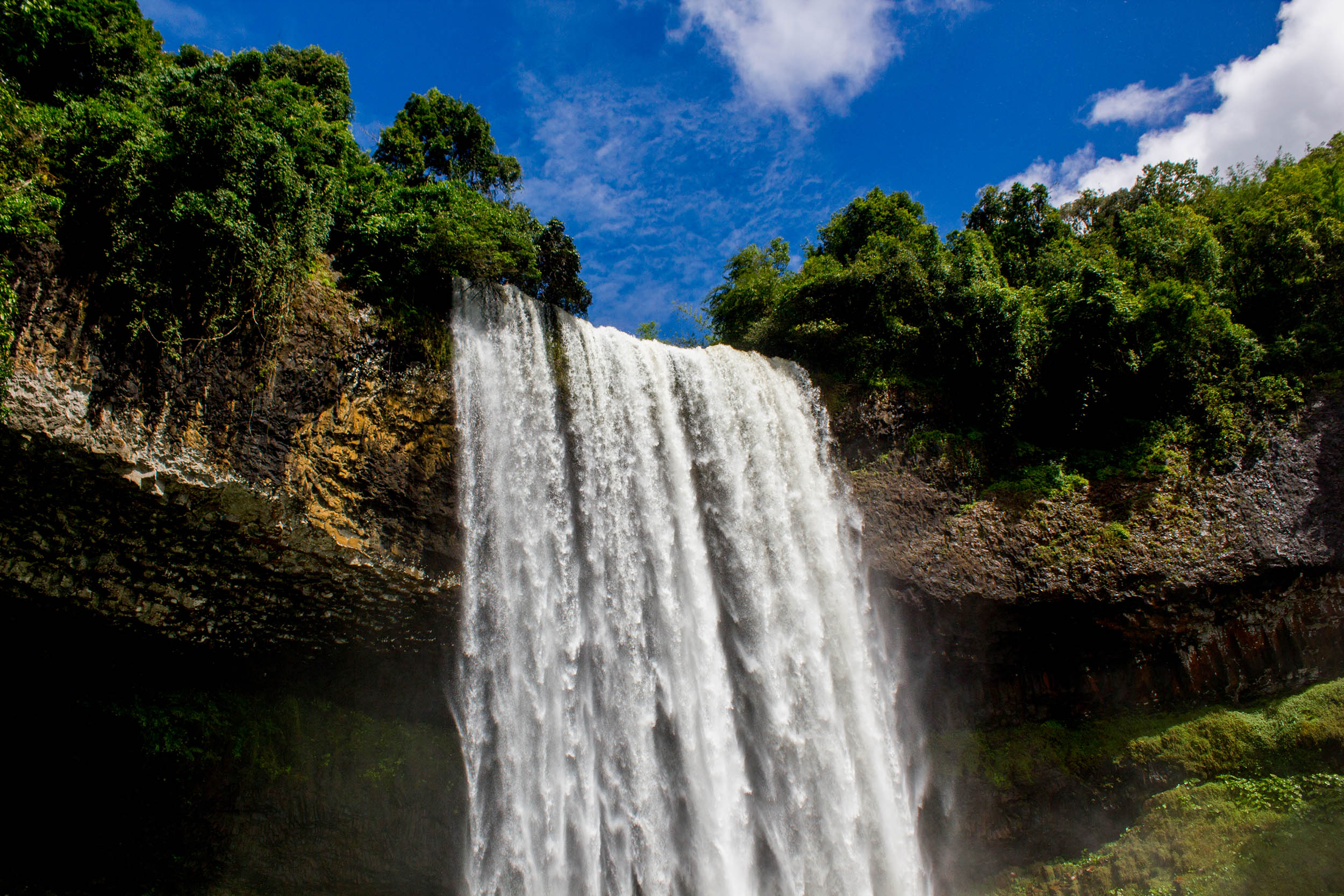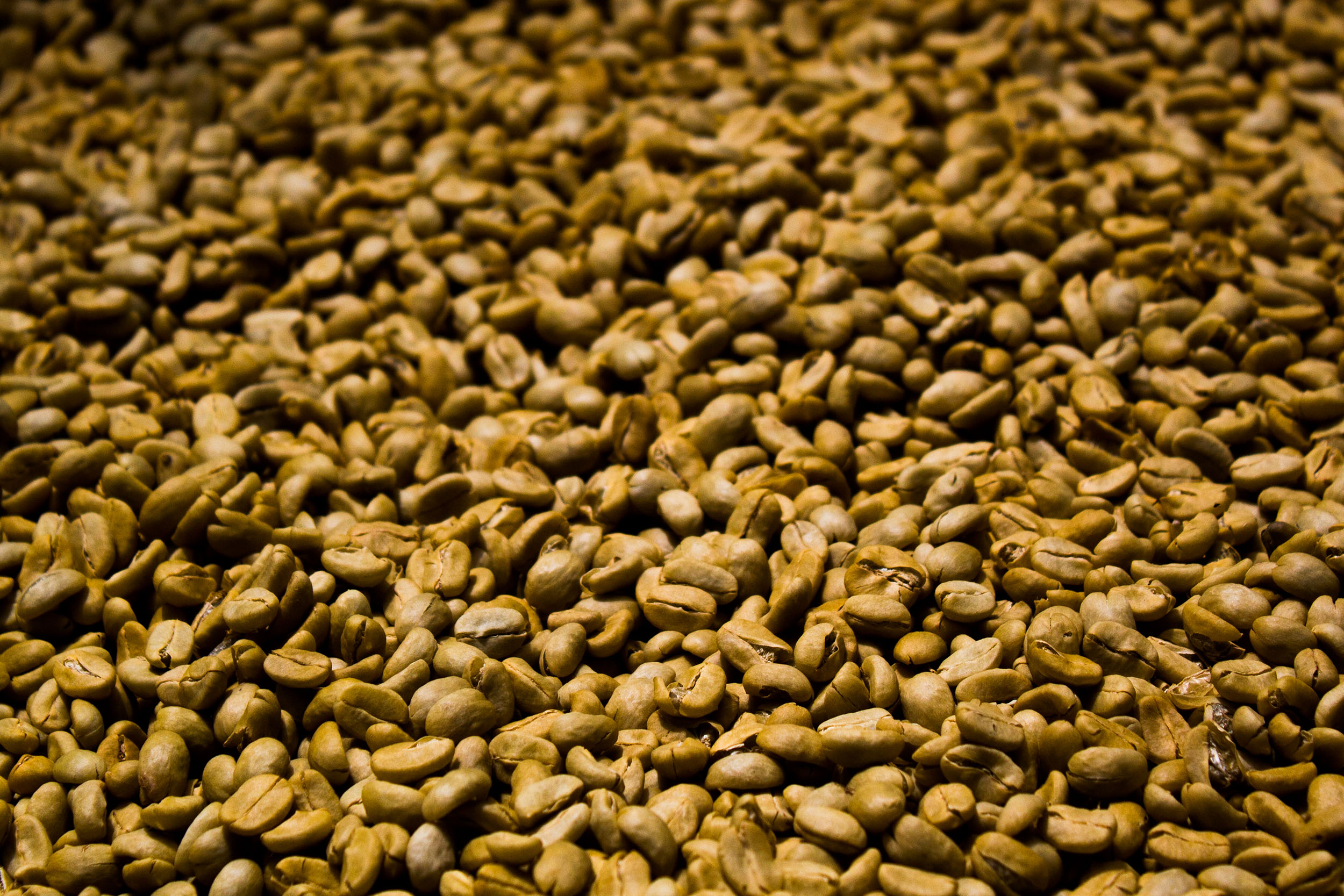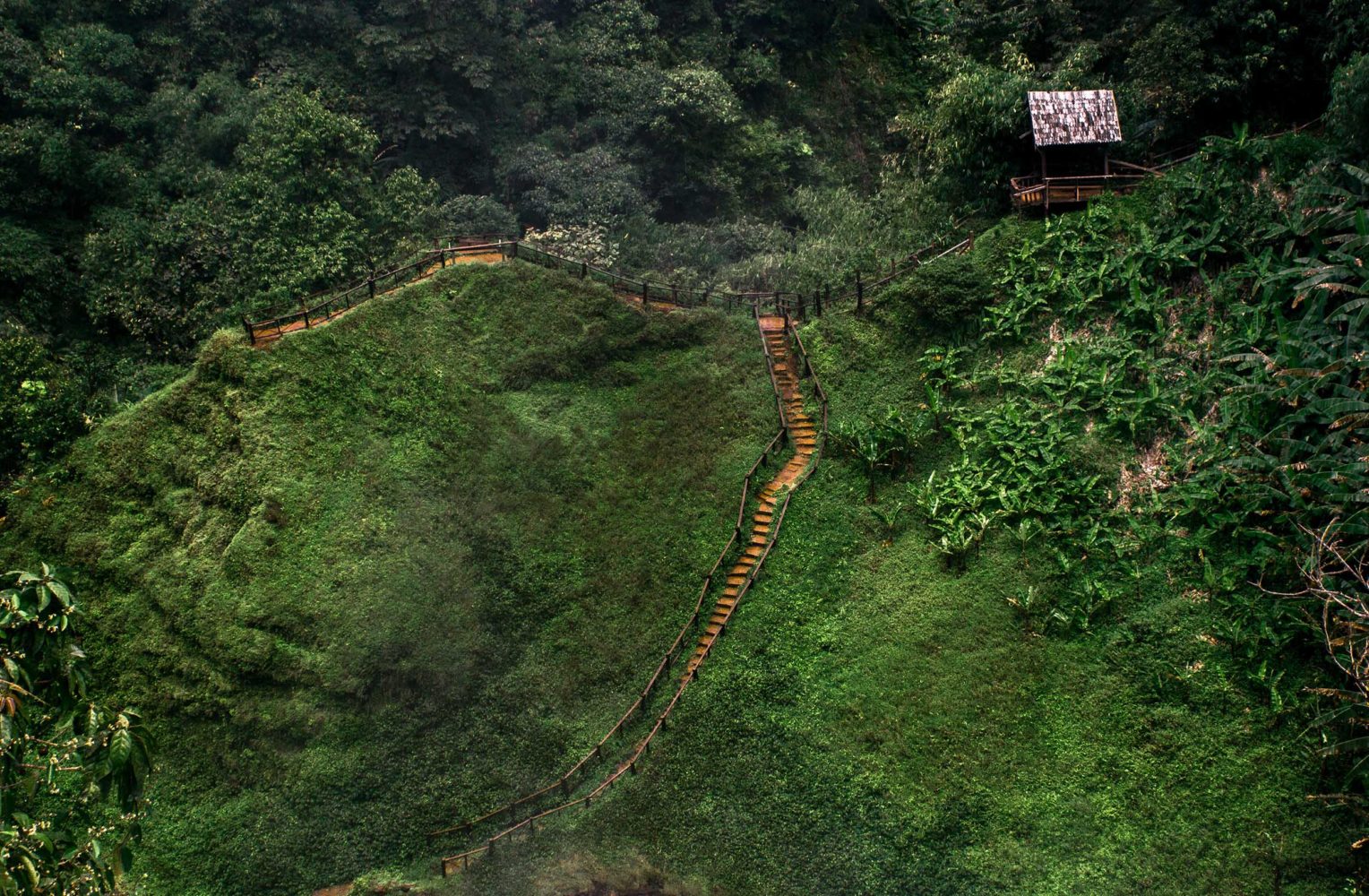Motorbiking High: The Bolaven Plateau
For most travellers, their motorcycle journey around the Bolaven Plateau will begin and end at the provincial capital of Pakse. This small and quiet city houses an enormous central market, which functions as a crucial hub between the region’s coffee, fruit, vegetable and spice growers; and Laos’ network of road, rail and riverboats connecting Pakse to Vientiane, and to the four countries that encircle landlocked Laos. For the tourist, all one needs to do is arrive in Pakse: a handful of operators are ready and waiting to set visitors up with motorbikes and hand-drawn maps.
The Ascent

Turning off the Laos national highway, just out of Pakse, our ascent begins. We pass the gleaming sickles and machetes of a blacksmith village, followed by a run of village stalls with elaborate wickerwork on display.
Wavering between our Honda Jazz’s peppy third and sluggish fourth gear, I feel a growing coolness in the air at speed. The sun continues to burn crisp and bright while roadside banks and ditches — scarred from heavy and regular rains — show a rich, dark-red soil. There’s something familiar about this landscape and its climate: we’re climbing into coffee country.
It’s here where French colonists first recognised the potential for a lucrative coffee industry. In the decades following the Vietnam War, the Laos government slowly eased its parental control over the coffee industry, and local, private growers have begun to cash in on a global demand for high-quality beans.
We pass a coffee processing facility, and continue upwards. The road so far has been steady and straight — I’ve barely noticed how much altitude we’ve gained. Leaving the sealed, utilitarian main road, we’re among coffee trees laden with ripening berries, carefully navigating the slippery, rutted road to our first waterfall, Tad Champee.
Parking the bike, we descend stairs cut from hard earth and a bamboo ladder in a perpetual state of both decay and repair: a floating mass of moisture drifts from the nearby falls, rotting the infrastructure and greasing each step.

The wide, 10 metre waterfall unloads a white blanket of water, churning up a pouch of mist that swirls and glimmers. Wild banana palms — green, wet and shiny — flank the falls. The surrounding jungle is bursting at its edges. Fig trees leer over the cliffside, limbs yearning for sunlight. They cast shadows, hang roots, and dapple the warm rays of the morning sun.
Swimming to the base of the cliff, we inch our way across slimy rocks into the scalloped recess behind the opaque cascade. We’re among leafy green plants, delicate orchids and the full noise of the falls. It’s eight in the morning here and we’re alone — an early start has served us well. The water is cool, so we bask in the low-angled sunlight at the basin’s calm side, and doze under the white noise and mist. An hour passes before the desire for coffee surpasses the incongruous peacefulness of this heavy, roaring torrent.
Returning to the main road, we find a specialist coffee shop purveying local beans. We drink coffee with a Laos coffee trader — who speaks to us solely in German — and eat halved avocados sprinkled with brown sugar: the coffee, rich and black; the avocados, sweet and nutty.
Moments away is the towering, two-tiered waterfall, Tad Yuan: a mere two kilometres from Tad Champee, yet on its own river, in its own valley. There seems to be no rhyme or reason to this place: the Plateau’s wide, flat top captures an immense amount of rainfall — averaging 3800 millimetres every year — before billowing out in all possible directions, down dozens of rivers, streams and drops before finding a way to the middle reaches of the Mekong River below. Here at Tad Yuan, we cross lax barriers and sit above the huge drop, looking over the vivid green and damp flora below.
The Plateau

It’s approaching midday and we’re riding flat-out for Paksong, the Plateau’s largest town. Every mild gain in altitude is represented by a new roadside crop: first, durian and jackfruit, then tomatoes and avocados. Up here there are these strange, thigh-thick bamboo shoots — some larger than the teenagers selling them.
A bulbous mass of clouds is darkening the landscape. The looming spectre of heavy rain forces us to take refuge in the food area of the Paksong market with hot broths and fresh coffee — shiny and motor-oil black — before the clouds slowly swallow themselves up, leaving the air clear and fresh.
Rolling across the open expanse of the plateau — 1000 metres above sea level — there is little evidence of the violent drops we’ve seen on the hillside below. The plateau itself seems calm and stark in comparison. Endless rows of coffee trees extend far out to the fringes of the flat land. I spot eucalyptus trees and notice the dirt is Australia-red. Water appears to waste little time on the tablelands: instead, it rapidly descends. As daylight wanes, we turn in to the business traveller-oriented Platinum Guesthouse for the night.
Next morning, taking a red-dirt detour, we’re following a recommendation to visit Tad Alang: one of the area’s best falls, located in a privately managed conservation area. The landscape here is beautifully forested. All morning we follow tracks that take us down valleys and along rivers, searching for waterfalls and swimming holes.
We hear Tad Alang long before we see it. Through dampened foliage, we see its symmetrical curtain, heavy and wide, plunging off a 30 metre, overhanging cliff. Around the falls are a cordon of banana palms, patches of pink orchids, drenched ferns, and rainbows thick and vivid. We’re in our raincoats, being bullied by the waterfall’s affronting wind and mist.
The heat of the middle hours arrive, so we relax and drink coffee at a small café. The owner fled the country during the rarely-mentioned bombing of Laos during the Vietnam War. She speaks of her life in Chicago: over 30 years of it, never dreaming of returning home. Lowering her coffee, she describes Laos’ changing landscape — social, economic — and her eventual decision to return, to take ownership of the land around these wondrous natural features, and care for the jungle and its waterways.
On some of the land grows organic pineapples, papayas, bananas, and of course, the deep black coffee we’re sipping. We look out across the forested ridges and gorges — perspiring in areas from far-away torrents — all under the guardianship of this remarkable woman. Great feelings of optimism accompany us as we leave this beautiful corner of the Plateau.
The Descent

Leaving the Plateau’s higher reaches, passing more waterfalls — including the roadside gem, Tad Katamtok — we reach the junction at Bane Beng. To the south, a thick screen of rain grumbles at our backs. Ahead of us — cupping the high, northern peaks — looms another dark block of cloud and precipitation. Heavy tropical raindrops sting my face and needle my hands for the 30 kilometres to Sekong. We stop again for therapeutic, hot broths before heading back into the lingering drizzle, onward to Tad Lo for our last night on the road.
On the other side of the rains, we gently descend into the late afternoon light as it reheats the lower plains of the Plateau’s north-east. In the clarity of the post-rain vista, hillsides sweat and the luminous afternoon sun throws warm and dramatic hues. We hit pockets of hot air that give relief to my knuckles and knees, while the sealed road gently steams beneath us. In the small villages along these stretches, a veritable barnyard of domesticated animals roam freely, all over the road.
Tad Lo is a popular one-day or overnight destination on the Bolaven Plateau. Accommodation is centred on some mellow rapids, and while the village itself is charming enough, it reflects a tourism industry that hasn’t quite figured itself out yet, making it both odd and endearing.

Our final day takes us around the Plateau’s northwest flank. Along the way, Mr Vieng offers educational tours of his coffee plantation, obligatory coffee tasting, and caffeinated conversation. The temperature climbs quickly as we continue our descent, so we pause for a swim and a lunch of the infamous durian and torso-sized jackfruit.
We make our final descent into Pakse city in time for a victory lap across the wide Mekong Bridge and up hundreds of steps to Phou Salao. From here, a great, golden Buddha sits, looking out over Pakse and the Bolaven Plateau. The sun begins to slip behind the hills and I think of all that water pouring over cliffs and swerving down gorges and valleys. I think of all the raw produce descending into Pakse, onward to other markets, and into bowls, cups and bellies across Laos. I think of the coffee — deep and black — and the richness of the land it comes from.

